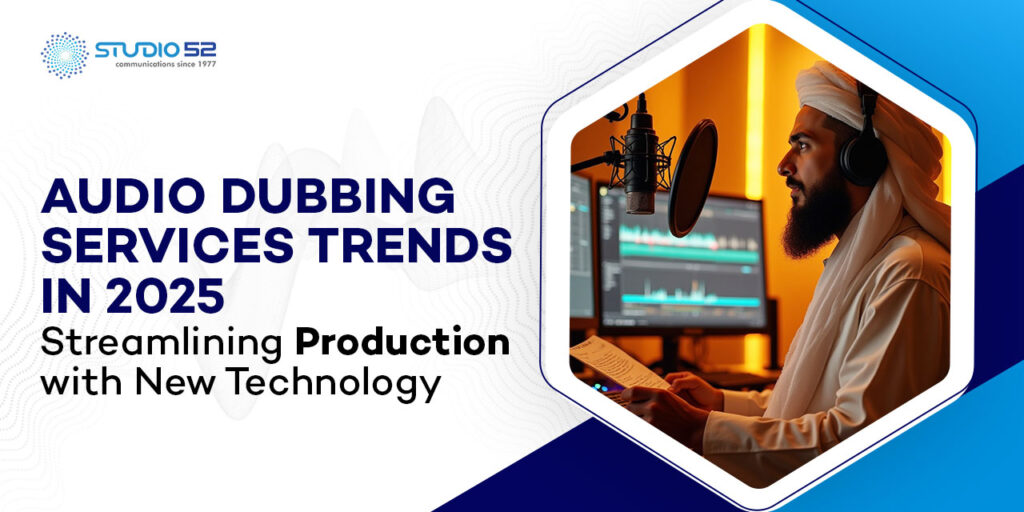Audio dubbing has emerged from a post-production requirement to a core element in global content distribution strategies. As we move into 2025, the field of dubbing is undergoing transformative shifts driven by AI integration, multilingual content demand, and the pursuit of production efficiency. These shifts are pushing professional audio dubbing services to adopt technologies that improve consistency, reduce turnaround time, and cater to increasingly diverse global audiences.
For content creators, streaming platforms, and media production companies, staying informed about audio dubbing services trends is a necessary move to remain competitive in a rapidly scaling media environment.
Table of Content
The Growing Demand for Audio Dubbing
The global entertainment industry continues to expand its reach across linguistic and cultural barriers. Streaming platforms, animation studios, e-learning providers, and gaming companies are now required to localise audio content for multiple regions simultaneously.
This rapid content expansion has directly increased the reliance on professional audio dubbing services. The demand is not limited to major languages anymore; regional and dialect-based dubbing is seeing significant uptake, requiring dubbing service provider companies to scale linguistically and operationally.
This demand is also influencing production timelines. Companies are under pressure to deliver high-quality dubbed content quickly, which is reshaping operational workflows and increasing dependence on real-time collaborative tools and cloud-based dubbing environments.
Key Trends Shaping Audio Dubbing Services in 2025
- AI Voice Cloning and Synthetic-Speech Integration
AI-generated voices are increasingly being used to accelerate dubbing timelines. These technologies allow faster adaptation of scripts without compromising on vocal tone, intonation, or emotion, elements once achievable only through human voice actors.
- Multilingual Cloud Dubbing Platforms
Centralised platforms now allow dubbing professionals, translators and sound engineers to collaborate remotely in real-time. These platforms streamline revision cycles and offer enhanced project transparency for best dubbing service providers handling high-volume international releases. - Script Localisation with NLP (Natural Language Processing)
Advanced NLP tools are now able to interpret cultural nuances and translate idiomatic expressions contextually, enabling content to maintain emotional integrity when dubbed into multiple languages. - Voice Actor Biometrics and Consistency Tools
Biometric tagging ensures consistency of a character’s voice throughout long-form or episodic content. This is particularly useful for large studios or a dubbing services provider company managing multiple seasons or franchise-based content. - Real-Time Lip Sync Technologies
Synchronisation algorithms have reached a point where they can adapt dialogue to mouth movements across various languages using automated systems, drastically reducing manual post-editing work.
Challenges in Implementing New Dubbing Technologies
Despite the advancements, integrating modern dubbing technologies presents a unique set of challenges:
- Voice Authenticity Concerns: AI-generated speech often lacks the emotional depth and nuance of a human voice actor, especially in emotionally intense or culturally sensitive content.
- Training and Infrastructure Costs: Adopting new systems requires investment in training staff, upgrading studio infrastructure, and managing new workflows, something not every dubbing service provider company is prepared for.
- Unequal Language Support: Not all languages and dialects are well-supported by current AI models, which can lead to inconsistency in output quality across multilingual projects.
- Intellectual Property and Consent: Using AI to replicate voices raises legal and ethical issues. Voice actors must give explicit consent, and clear policies around data usage and voice ownership need to be established.
- Workflow Disruption: Switching from traditional workflows to cloud-based or AI-powered systems can cause temporary slowdowns, especially when legacy systems are deeply embedded in operations.
Benefits of Embracing Dubbing Innovations
For those who adapt early, the benefits are considerable. New technologies reduce production time, allowing professional audio dubbing services to handle larger volumes with shorter delivery cycles. This supports simultaneous multilingual releases, critical for streaming platforms aiming for synchronised global premieres.
AI-assisted dubbing also offers scalability. Once a voice model is trained and approved, it can be reused across formats, from long-form series to video games, ensuring tonal consistency. Cloud platforms reduce physical infrastructure needs, making them more cost-effective and efficient for best dubbing service providers operating in multiple regions.
Moreover, script localisation improvements mean the end product feels less like a translation and more like native content, which enhances viewer engagement and retention across cultural contexts.
Case Studies: Success Stories with New Dubbing Technologies
Streaming Platform Localises 200+ Titles Using AI-Based Dubbing
A global streaming company collaborated with a professional audio dubbing services team using AI-voice synthesis. The result was a 42% reduction in production time and an increase in dubbed content availability across seven new markets within one quarter.
Education Firm Enhances Multilingual Courses
An e-learning platform worked with a dubbing service provider company that implemented cloud-based collaboration tools. This improved content synchronisation across modules, allowing the release of new courses in five languages simultaneously, accelerating regional adaptation by 64%.
Future Outlook: What’s Next in Audio Dubbing
Looking ahead, audio dubbing services trends indicate stronger convergence between machine learning and human creativity. While AI will take on more repetitive tasks, voice actors will still be vital for high-emotion and narrative-driven content.
We are likely to see the rise of adaptive dubbing, where a single dubber version is modified algorithmically for different dialects or cultural preferences. Additionally, greater regulatory oversight on synthetic voices and data use will emerge, driving the need for transparent dubbing workflows.
With new opportunities come responsibilities, especially for the best dubbing service provider aiming to maintain quality, authenticity, and compliance in multilingual content creation.
Conclusion
2025 marks a transformative year for dubbing. From AI voice cloning to cloud collaboration platforms and NLP-based localisation, the sector is moving toward faster, scalable, and more intelligent solutions. While challenges remain in training, voice authenticity, and legal clarity, the trajectory is clear: technology is shaping a more dynamic dubbing landscape.
Staying informed on audio dubbing services trends and working with the right dubbing service provider company can make the difference between keeping up and falling behind in today’s fast-paced content production ecosystem.
If you’re looking to streamline your dubbing pipeline, expand into multilingual markets, or simply enhance your production efficiency, it’s time to partner with professionals who understand both technology and storytelling.
Studio52 offers tailored solutions built for the demands of 2025 and beyond. As a best dubbing service provider, we combine advanced tools, experienced linguists, and a scalable workflow to deliver results that meet today’s speed and quality requirements. Explore how we can support your next project with industry-leading professional audio dubbing services. Get in touch with us now and transform how you localise content.


